
Galicia is an autonomous community of Spain and historic nationality under Spanish law. Located in the northwest Iberian Peninsula, it includes the provinces of A Coruña, Lugo, Ourense, and Pontevedra.

Ourense is a province of Spain, in the southeastern part of the autonomous community of Galicia. It is bordered by the provinces of Pontevedra to the west, Lugo to the north, León and Zamora, to the east, and by Portugal to the south. With an area of 7,278 square km., it is the only landlocked province in Galicia. The provincial capital, Ourense, is the largest population centre, with the rest of the province being predominantly rural.

Chaves is a city and a municipality in the north of Portugal. It is 10 km south of the Spanish border and 22 km south of Verín (Spain). The population of the entire municipality in 2011 was 41,243, in an area of 591.23 km2. The municipality is the second most populous of the district of Vila Real. With origins in the Roman civitas Aquæ Flaviæ, Chaves has developed into a regional center. The urban area or city proper has 17,535 residents (2001).
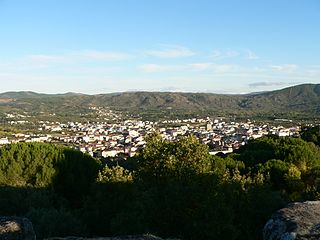
Verín is a town and municipality in the southeast of the province of Ourense, in the autonomous community of Galicia, Spain. The population of the municipality is about 14,433. It is located 70 kilometers east of the provincial capital of Ourense and 15 kilometers north of the Portuguese city of Chaves. The Tâmega River flows through the town. In the Middle Ages it was known as Santa María de Verín.
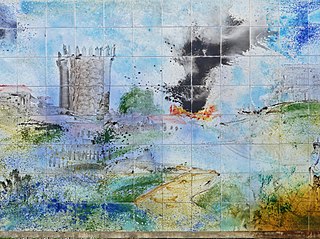
The siege of Chaves refers to the French siege and capture of Fort São Francisco and the town of Chaves, Portugal from 10 to 12 March 1809, and the subsequent siege and recapture of the fort by Portuguese forces from 21 to 25 March 1809, during the second French invasion of Portugal in the Peninsular War.

Ourense is a city and the capital of the province of Ourense, located in the autonomous community of Galicia, northwestern Spain. It is on the Camino Sanabrés path of the Way of St James, and is crossed by the Miño, Barbaña, Loña and Barbañica rivers. It is also known as A cidade das Burgas due to its hot springs, being one of the European cities with the greatest thermal heritage.

Allariz is a town and municipality in the province of Ourense, in the autonomous community of Galicia, Spain. It occupies the center of the western half of the province, connecting with the towns (concellos) of Taboadela, Paderne, Sandiás, Vilar de Santos, Rairiz de Veiga, Xunqueira de Ambía, A Merca and A Bola. The area of the municipality is 85,3 km² and there are 6.188 inhabitants in 16 parishes.
The Xunta de Galicia is the collective decision-making body of the government of the autonomous community of Galicia, composed of the President, the Vice-President(s) and the specialized ministers (Conselleiros).

Monterrei is a municipality in the province of Ourense, in the autonomous community of Galicia, Spain. It belongs to the comarca of Verín.

Riós is a municipality in the province of Ourense, in the autonomous community of Galicia, Spain. It belongs to the comarca of Verín. It has a population of 2032 and an area of 114 km².

The Picoña Castle is a Portuguese medieval fortification now situated in the Spanish municipality of Calvos de Randín, Ourense, Galicia. The castle, now in ruins, dates back to the early period of Portuguese independence and was constructed over a previous Callaeci fort. In 1650 it was destroyed by Castilian troops during the Portuguese war of Restoration.
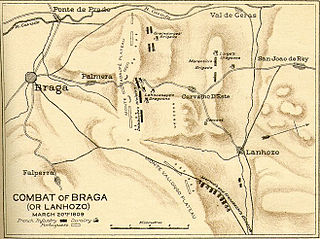
The Battle of Braga or Battle of Póvoa de Lanhoso or Battle of Carvalho d'Este saw an Imperial French corps led by Marshal Nicolas Soult attack a Portuguese army commanded by Baron Eben. When Soult's professional soldiers attacked, the Portuguese at first fought back but soon ran away. The French slaughtered large numbers of their opponents, who were mostly badly disciplined and poorly armed militia. The action was part of the second invasion of Portugal, during the Peninsular War.
Luis Rodríguez Vaz is a Spanish football manager.
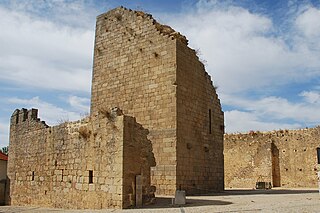
The Castle of Miranda do Douro, is a Portuguese medieval castle in civil parish of Miranda do Douro, in the municipality of the same name, in the district of Bragança.

The Castle of Santo Estêvão is a medieval castle located in the civil parish of Santo Estêvão, municipality of Chaves, in the Portuguese district of Vila Real. Located in a dominant position over the village, the castle is within walking distance of the course of the river Tamega and the border with Spain.

Paradores de Turismo de España S.M.E.S.A., branded as Paradores, is a Spanish state-owned chain of luxury hotels that are usually located in historic buildings or in nature areas with a special appeal. Its very first parador was inaugurated on 9 October 1928 in Navarredonda de Gredos (Ávila). As of 2022, it operates 97 paradores in Spain and one in Portugal, with 5,988 rooms in total. Every parador has its own restaurant offering the regional gastronomy of its area.
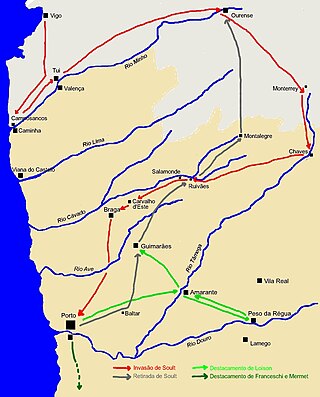
The Second French invasion of Portugal, a campaign of the Peninsular War, commenced on 3 February 1809 with French Marshal Soult's II Corps heading down from La Coruña, in the north of Spain to occupy the capital of Portugal, Lisbon.

The Battle of Monterrey was a battle fought during the Peninsular War outside Monterrey, Orense, in Spain. Resulting in a French victory, it took place in the early stages of Marshal Soult's Second French invasion of Portugal.
















